Discover 25 hidden attractions, cool sights, and unusual things to do in Serbia. Don't miss out on these must-see attractions: Petrovaradin Fortress (Novi Sad), Museum of Aviation (Belgrade) or Belgrade Zoo (Belgrade).
Below, you can find the list of the most amazing places you should visit in Serbia.
Table of Contents
Petrovaradin Fortress, Novi Sad
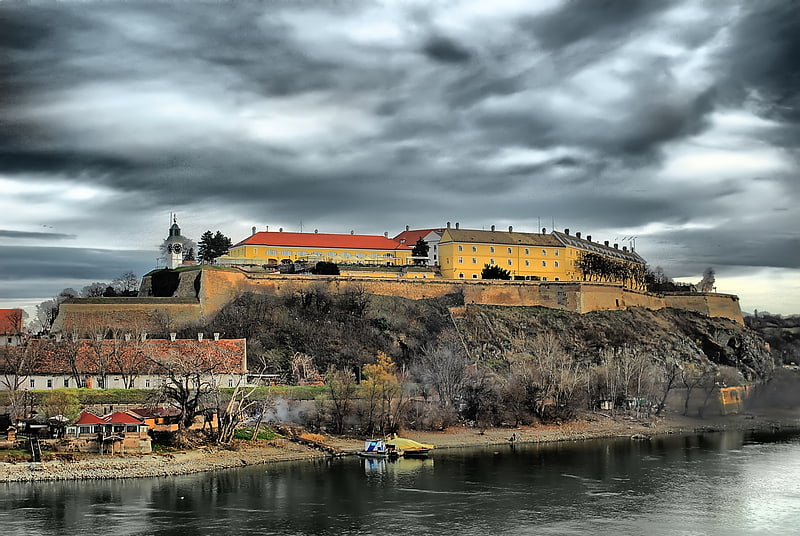
Also known as: Петроварадинска тврђава
Fortress in Petrovaradin, Serbia. Petrovaradin Fortress, nicknamed "Gibraltar on/of the Danube", is a fortress in the town of Petrovaradin, itself part of the City of Novi Sad, Serbia. It is located on the right bank of the Danube river. The cornerstone of the present-day southern part of the fortress was laid on 18 October 1692 by Charles Eugène de Croÿ. Petrovaradin Fortress has many tunnels as well as 16 kilometres of uncollapsed underground countermine system.
In 1991 Petrovaradin Fortress was added to Spatial Cultural-Historical Units of Great Importance list of the Republic of Serbia.[1]
Museum of Aviation, Belgrade
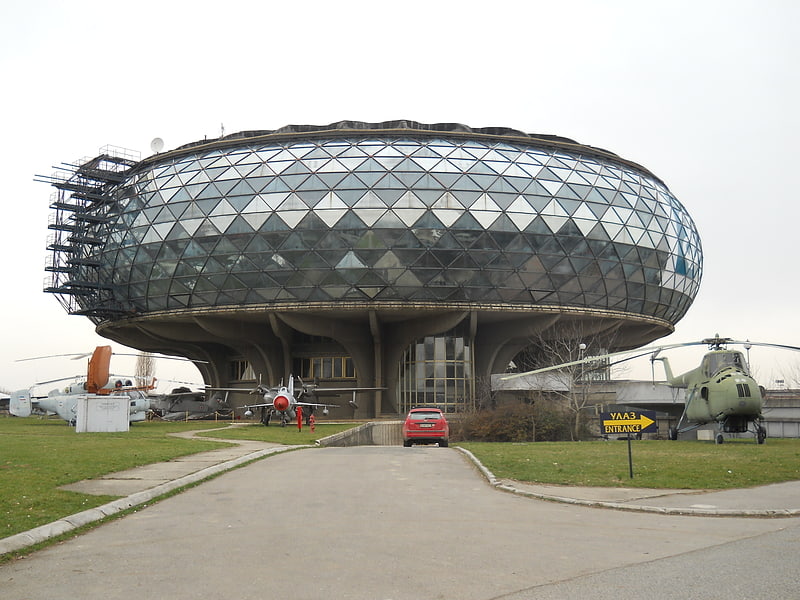
Also known as: Музеј ваздухопловства — Београд
Aircraft exhibits in a unique building. The Aeronautical Museum Belgrade, formerly known as the Yugoslav Aeronautical Museum, is a museum located in Surčin, Belgrade, the capital of Serbia. Founded in 1957, the museum is located adjacent to Belgrade Nikola Tesla Airport. The current facility, designed by architect Ivan Štraus, was opened to the public on 21 May 1989.[2]
Address: P.O.Box 35, 11271 Beograd
Belgrade Zoo, Belgrade
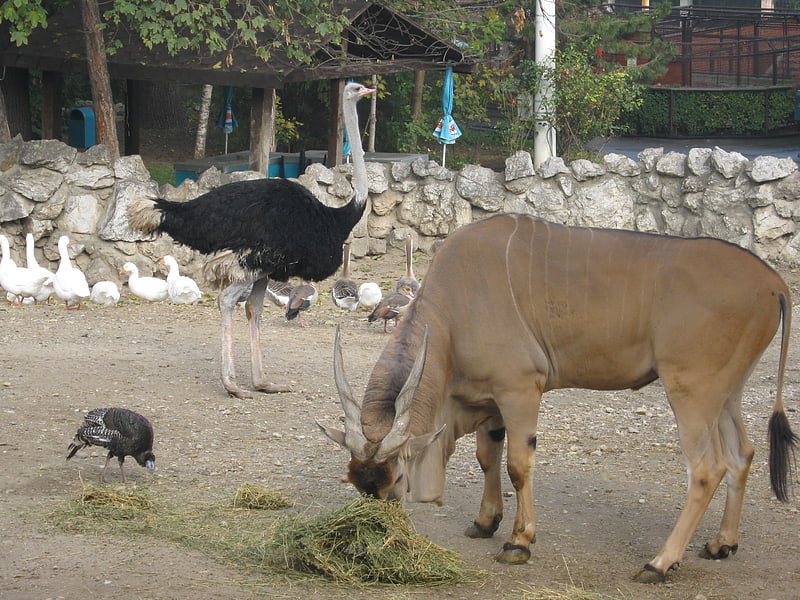
Also known as: Београдски зоолошки врт
Small city zoo with lions and tigers. Beo zoo vrt, also known as Vrt dobre nade, is a publicly owned zoo located in Kalemegdan Park, downtown of Belgrade, Serbia. Established on July 12, 1936, it is considered to be one of the oldest public zoos in southeastern Europe. The zoo covers 7 hectares and houses a collection of 210 animal species, with approximately 800 individuals, making it the largest zoological garden in Serbia. With around 400,000 annual visitors it is also recognized as one of the most popular tourist attractions in Belgrade.
Belgrade zoo officially applied for EAZA membership in 2017.[3]
Address: Mali Kalemegdan 8, 11000 Belgrade (Stari Grad)
Pobednik, Belgrade
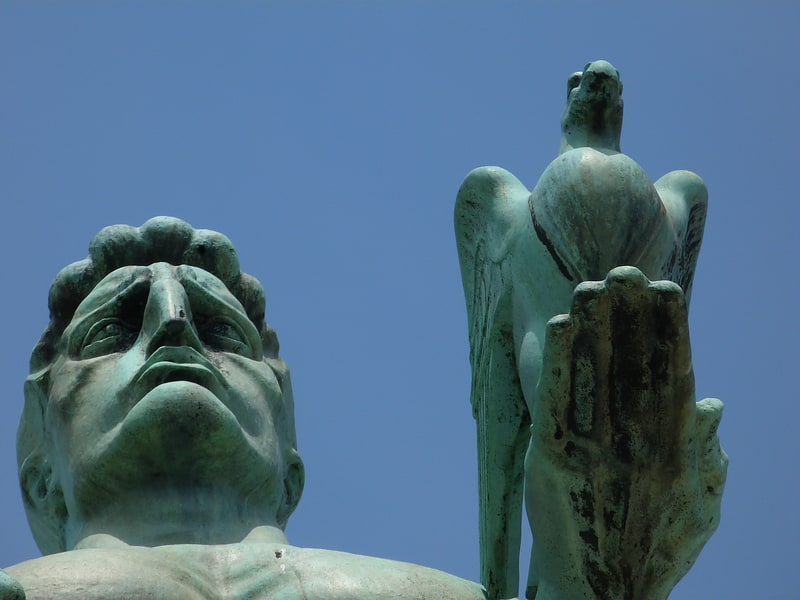
Also known as: Победник
Iconic monument of the Balkan War. Pobednik is a monument in the Upper Town of the Belgrade Fortress, built to commemorate Serbia's victory over Ottoman and Austro-Hungarian Empire during the Balkan Wars and the First World War. Cast in 1913, erected in 1928, and standing at 14 metres high, it is one of the most famous works of Ivan Meštrović. It is also one of the most visited tourist attractions in Belgrade and the city's most recognizable landmark.
It is a standing bronze male figure in the nude with a falcon in the left hand and a sword in the right (as symbols of peace and war), modelled by the sculptor Ivan Meštrović, set on a pedestal in the form of a Doric column on a tall cubic base, designed by the architect Petar Bajalović. The statue looks forward across the confluence of the Sava and the Danube, and over the vast Pannonian plain, towards the very distant Fruška Gora mountain (until 1918 a domain of Austro-Hungarian empire), it is probably the most powerful, most popular visual symbol of Belgrade.
The statue was removed from the column in October 2019 for repairs. It was returned on the pedestal after the restoration on 14 February 2020.[4]
Address: Bulevar vojvode Bojovića, Belgrade (Stari Grad)
Danube Park, Novi Sad
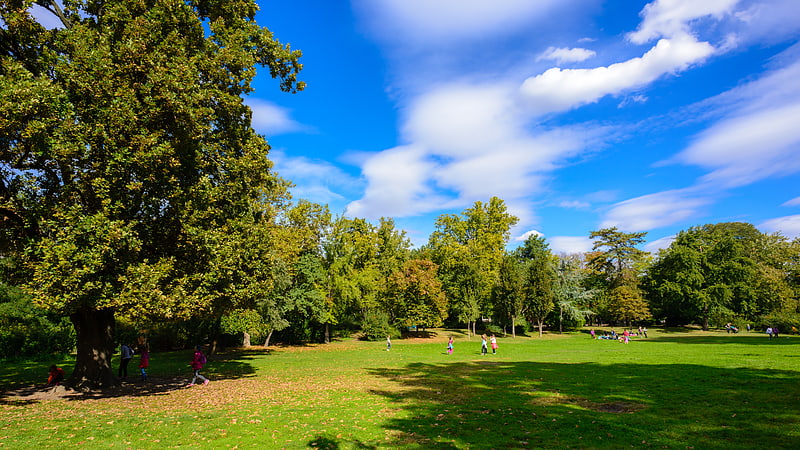
Park in Novi Sad, Serbia. Danube Park or Dunavski Park is an urban park in the downtown of Novi Sad, the capital of the Vojvodina Province, Serbia. Formed in 1895, it is protected as the natural monument and is one of the symbols of the city.[5]
Gallery of Matica Srpska, Novi Sad
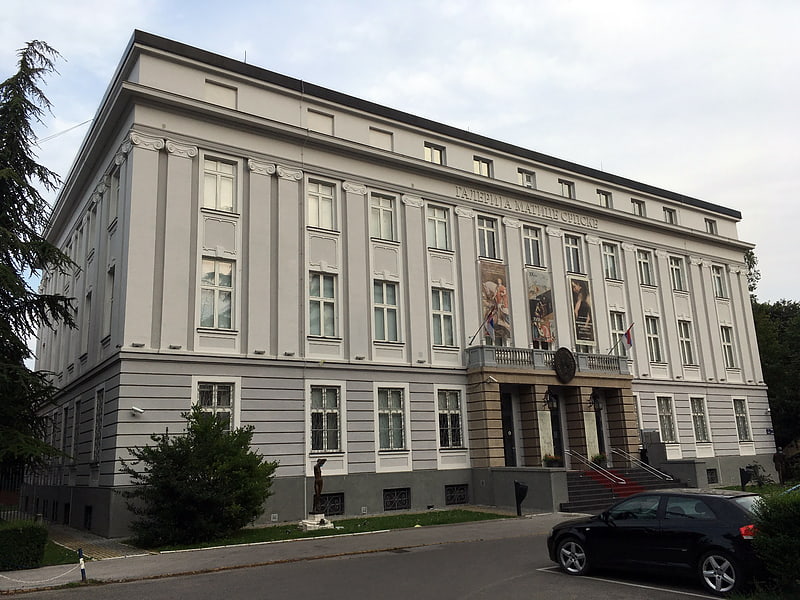
The Gallery of Matica Srpska is one of the largest and oldest galleries in Serbia. It is located in the central zone of Novi Sad, next to Pavle Beljanski Memorial Collection.
The Gallery was established on the 14th of October 1847, with contributions from Sava Tekelija who left a valuable family portrait collection to the Matica Srpska, and other Serb merchants who made endowments and donations to the gallery.
The building of Gallery of Matica Srpska was declared a Monument of Culture of Great Importance in 1979.
The Gallery of Matica Srpska has acted as an independent institution apart from Matica Srpska since 1958. Collections in The Gallery of Matica Srpska mostly consists of paintings from all periods of the national history of art.[6]
Address: Trg Galerija 1, 21101 Novi Sad
Čair Sports Center, Niš
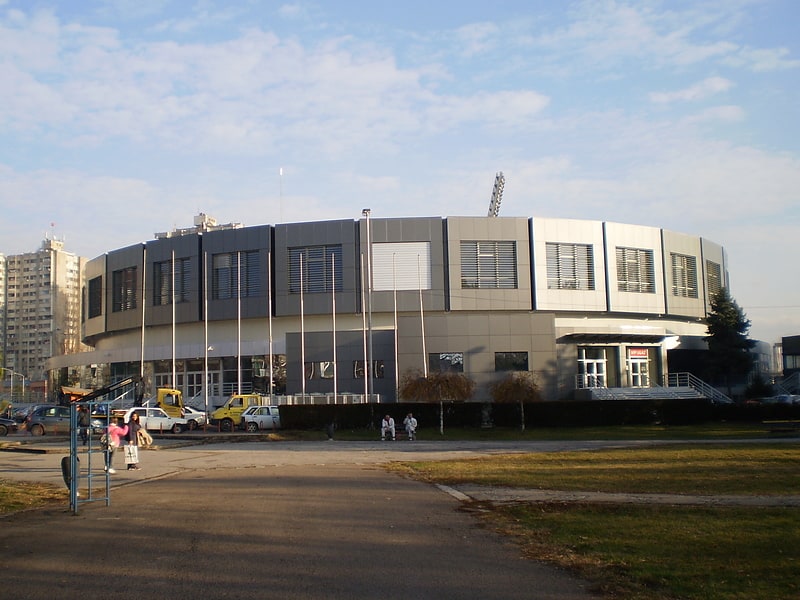
Also known as: Спортски центар Чаир
Sports arena in Niš, Serbia. Čair Sports Center, commonly known as Čair Hall is an indoor sporting arena located in Niš, Serbia. The seating capacity of the arena is 4,800 for sports events and 6,500 at concerts. It is home to the KK Konstantin basketball team, RK Železničar 1949 handball team and OK Niš volleyball team.[7]
Address: IX brigade 10, 18000 Nis
Skull Tower, Niš
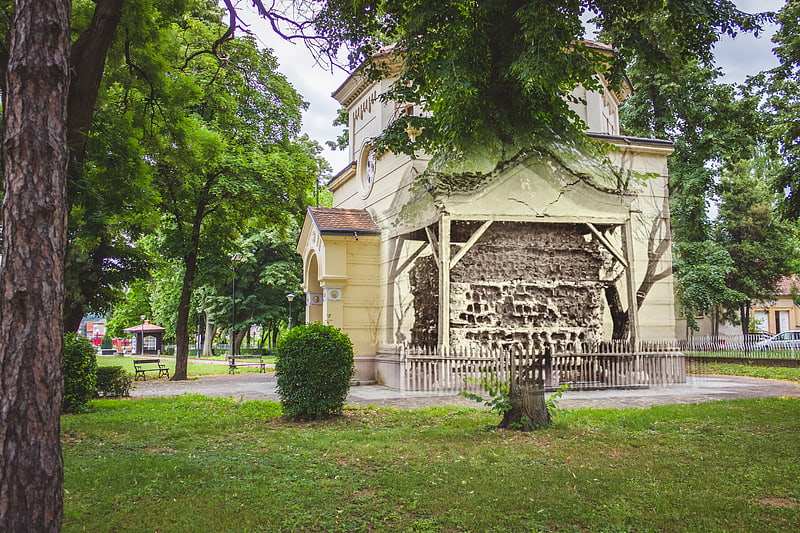
Also known as: Ћеле-кула
Tower in Niš, Serbia. Skull Tower is a stone structure embedded with human skulls located in Niš, Serbia. It was constructed by the Ottoman Empire following the Battle of Čegar of May 1809, during the First Serbian Uprising. During the battle, Serbian rebels under the command of Stevan Sinđelić were surrounded by the Ottomans on Čegar Hill, near Niš. Knowing that he and his fighters would be impaled if captured, Sinđelić detonated a powder magazine within the rebel entrenchment, killing himself, his subordinates and the encroaching Ottoman soldiers. The governor of the Rumelia Eyalet, Hurshid Pasha, ordered that a tower be made from the skulls of the fallen rebels. The tower is 4.5 metres high, and originally contained 952 skulls embedded on four sides in 14 rows.
In 1861, Midhat Pasha, the last Ottoman governor of Niš, ordered that Skull Tower be dismantled. Following the Ottomans' withdrawal from Niš in 1878, the structure was partially restored and roofed over with a baldachin. Construction of a chapel surrounding the structure commenced in 1892 and was completed in 1894. The chapel was renovated in 1937. A bust of Sinđelić was added the following year. In 1948, Skull Tower and the chapel enclosing it were declared Cultural Monuments of Exceptional Importance and came under the protection of the Socialist Republic of Serbia. Further renovation of the chapel occurred again in 1989.
As of 2022, 58 skulls remain embedded in Skull Tower's walls. The one that is said to belong to Sinđelić is enclosed in a glass container adjacent to the structure. Seen as a symbol of independence by many Serbs, it has become a popular tourist attraction, visited by between 30,000 and 50,000 people annually.[8]
Address: Bulevar Dr Zorana Dindica, Niš
Niš Fortress, Niš
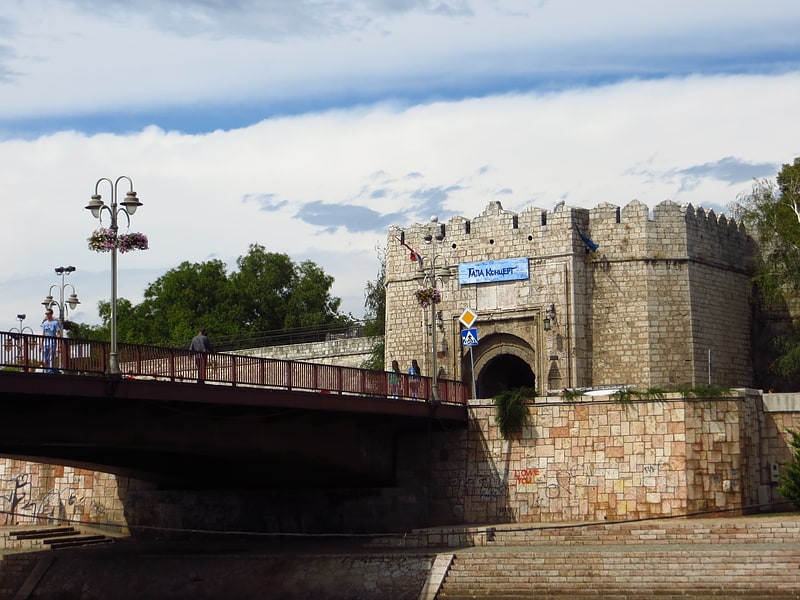
Also known as: Нишка тврђава
Fortress in Niš, Serbia. Niš Fortress is a fortress in the city of Niš, Serbia. It is a complex and important cultural and historical monument. It rises on the right bank of the Nišava River, overlooking the area inhabited for longer than two millennia. It was protected by law in May 1948 as it was declared a cultural site of great significance. The current condition of the fortress lists it as one of the best preserved fortifications of this kind in Serbia as well as on the Balkan Peninsula.[9]
Amidža Konak, Kragujevac
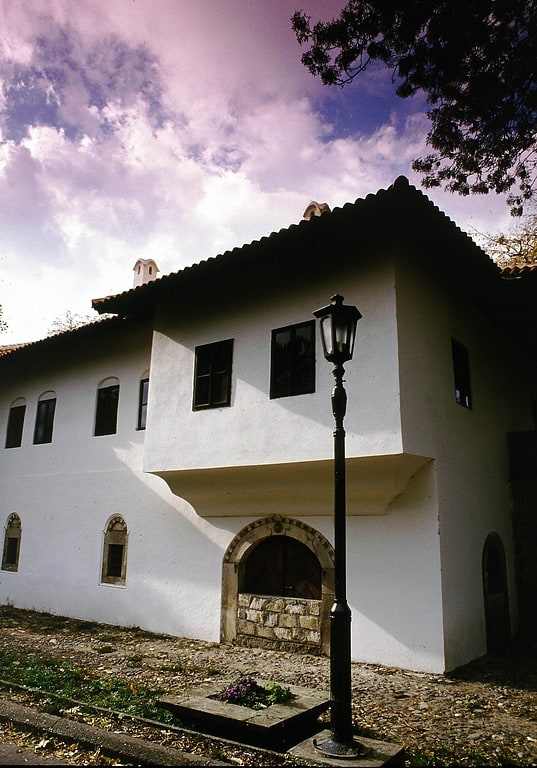
Also known as: Амиџин конак
Museum in Kragujevac, Serbia. Amidža Konak is a 19th-century residence of Turkish-style architecture located in the old part of the city of Kragujevac in central Serbia. It was built in 1819-1824 by Serbian Prince Miloš Obrenović, and it was named after Sima Milosavljević-Paštrmac, called Amidža, a Serbian hajduk and staff member of the court of Obrenović. Only Amidža Konak remained from large complex of building that existed during Miloš Obrenović time. Nearby, Miloš's Konak existed, and it was destroyed in 1941, during World War II, and also, Princess Ljubica Konak, that burned down in 1884.
Amidža Konak served as a residence of Sima and his colleagues that passed through Kragujevac, and now serves as a national museum.
It is part of Cultural Monuments of Great Importance.[10]
Princely Serbian Theatre, Kragujevac
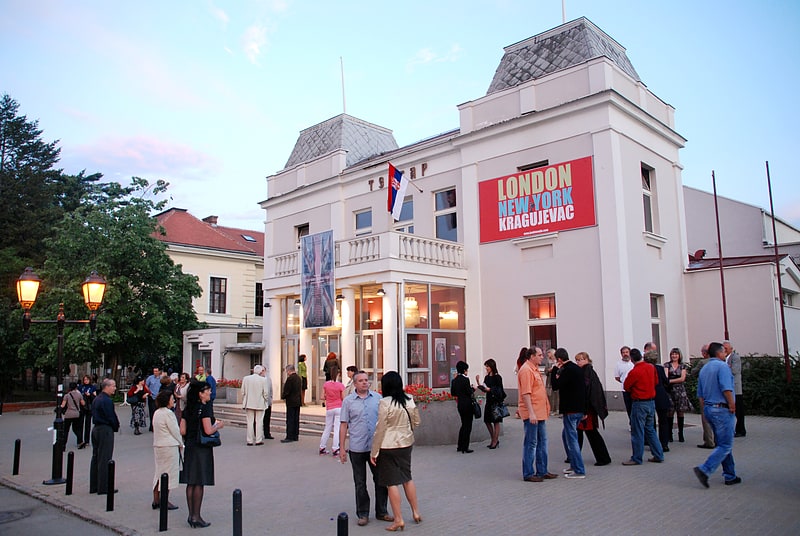
Also known as: Књажевско-српски театар
Theatre in Kragujevac, Serbia. The Princely Serbian Theatre is the oldest theatre in Central Serbia. It is based in City of Kragujevac, the fourth largest city of Serbia. The theatre was founded in 1835 by Miloš Obrenović, Prince of Serbia. In the time when theatre was founded, Kragujevac was the first capital of the Principality of Serbia.[11]
Address: Kragujevac, Daničićeva 3
Šumarice Memorial Park, Kragujevac
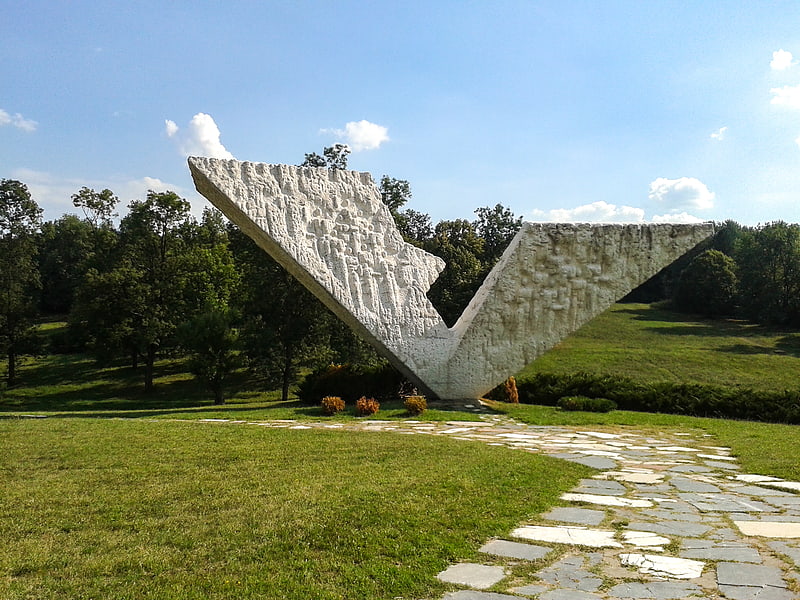
October in Kragujevac Memorial Park, also known as Šumarice Memorial Park, is the site near Kragujevac, Serbia of the execution of an estimated 2,800 men and boys of the town by the German occupation forces on October 21, 1941, during World War II. Among the dead were hundreds of high school students. The 21 October Museum was designed by architect Ivan Antić is located at the site of the massacre.
Monuments within the park include the monument to the murdered schoolchildren and their teachers (the "Interrupted Flight" monument) by sculptor Miodrag Živković; the "Monument of pain and defiance" by sculptor Ante Gržetić; the "One hundred for one" monument by Nandor Glid; the "Resistance and Freedom" monument by Gržetić; and the Shoeshiners monument ("Crystal Flower") by architect Nebojša Delja. The complex also contains the Monument to the Slovaks killed during the World War I and the old World War I military cemetery with a Monument to Serbian soldier.
In December 2020 an exhibit about the Jasenovac concentration and extermination camp was held.[12]
Grgeteg monastery, Fruška Gora
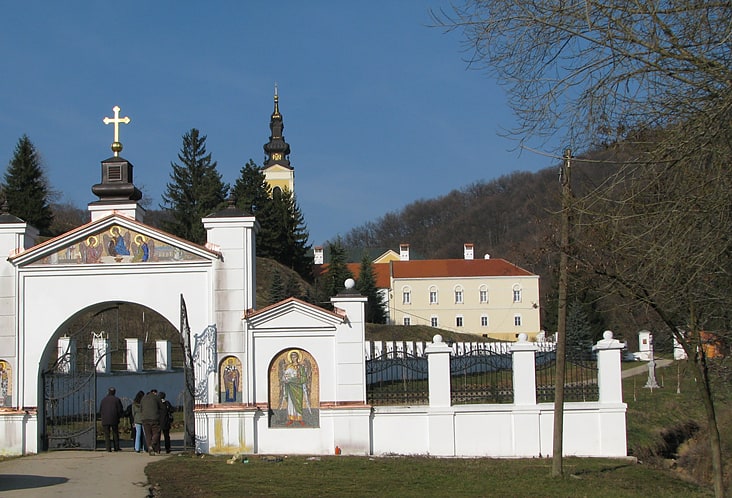
Also known as: Манастир Гргетег
Monastery in Grgeteg, Serbia. The Grgeteg Monastery is a Serb Orthodox monastery on the Fruška Gora mountain in the northern Serbia, in the province of Vojvodina. According to tradition, the monastery was founded by Zmaj Ognjeni Vuk in 1471. The earliest historical records about the monastery date back to 1545/1546. The monastery had been deserted before the 1690 Great Migration of the Serbs, but a renewal, undertaken by Bishop Isaija Đaković, took place in 1708. Around 1770, the extant baroque church was erected and it underwent restoration in 1898 under the guiding hand of Hermann Bollé. It was then that the residential buildings which enclose the church from all four sides were reconstructed. The first walled rocaille iconostasis in the church interior was painted and inlaid by Jakov Orfelin in 1774–1775. The extant iconostasis is a 1902 work of Uroš Predić.
Grgeteg Monastery was declared Monument of Culture of Exceptional Importance in 1990, and it is protected by Republic of Serbia.[13]
Vršac Castle, Vršac
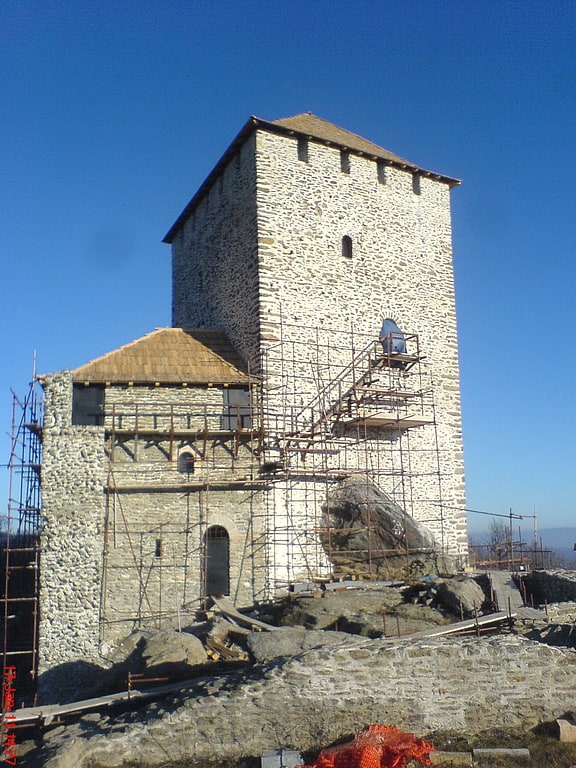
Also known as: Вршачки замак
Historical landmark in Vršac, Serbia. Vršac Castle formerly known as "Vršac Tower" is a medieval fortress near Vršac, Vojvodina, Serbia. Only Donjon tower remained from the entire complex, but in 2009 reconstruction started, to recreate the entire Vršac Castle.
Vršac Castle was declared a Monument of Culture of Great Importance in 1991, and is protected by the Republic of Serbia.[14]
Address: Prvomajska Bb, 26300 Vrsac
Novo Hopovo monastery, Fruška Gora
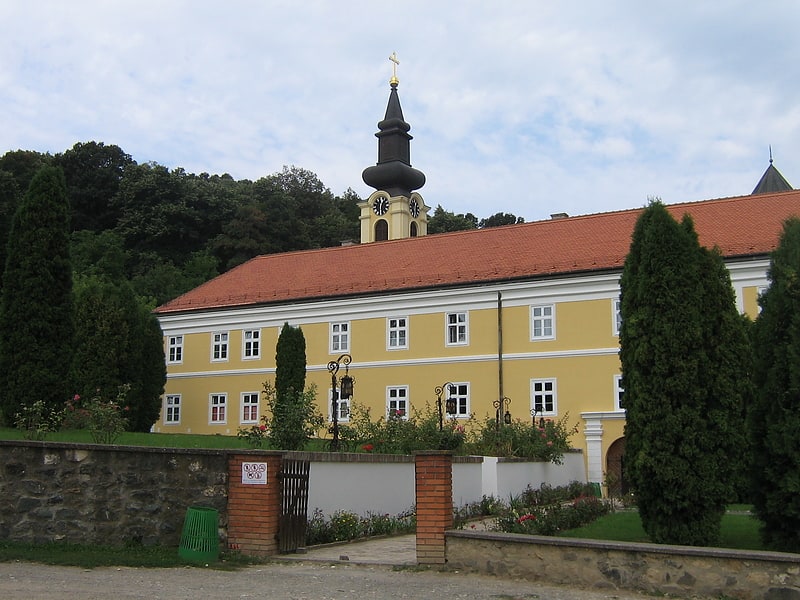
Also known as: Манастир Ново Хопово
Monastery in Serbia. The Novo Hopovo Monastery is a Serb Orthodox monastery on the Fruška Gora mountain in northern Serbia, in the province of Vojvodina. According to tradition, the monastery was built by the Despots of the House of Branković. The first written mention of the monastery was made in 1451, and the latest mention of the monastery dates back to 1641. The extant church was erected in 1576 and the bell-tower with the small St. Stephen's Chapel upstairs was built between 1751 and 1758. The monastic residences were constructed in several stages, from 1728 until 1771. The icons were painted in 1776 by Teodor Kračun.
The Novo Hopovo Monastery was declared Monument of Culture of Exceptional Importance in 1990, and it is protected by the Republic of Serbia.[15]
Address: Fruska Gora mountain in northeast of Irig, Fruška Gora
Staro Hopovo monastery, Fruška Gora
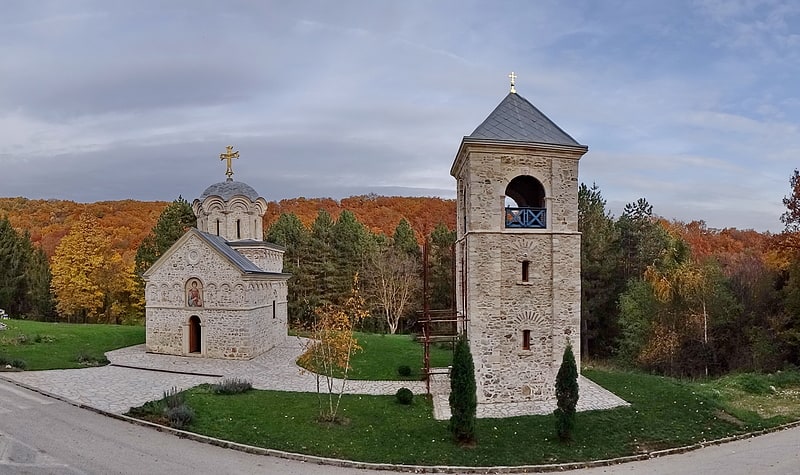
Also known as: Манастир Старо Хопово
Monastery in Serbia. The Staro Hopovo Monastery is a Serb Orthodox monastery on the Fruška Gora mountain in the northern Serbia, in the province of Vojvodina. According to tradition, the monastery was founded by Bishop Maksim. The first reliable mention of the monastery dates back to 1545/1546. It is on the basis of some data from 1751 that an earlier church with timber walls dedicated to St. Nicholas existed. The old church which had collapsed in an earthquake was in 1752 substituted with the extant single-nave building dedicated to St. Panteleimon. The woodcarving of the iconostasis of Staro Hopovo was completed in 1793, and the paintings by Janko Halkozović and Kuzman Kolarić.
Staro Hopovo Monastery was declared Monument of Culture of Exceptional Importance in 1990, and it is protected by Republic of Serbia.[16]
Millennium Centar, Vršac

Also known as: Центар Миленијум
Arena in Vršac, Serbia. The Millennium Centar is a multi-purpose indoor arena located in the city of Vršac. It is the home ground of basketball club KK Vršac and ŽKK Vršac and has a capacity of 4,400 seats. The arena is also used for concerts and other live entertainment.[17]
Address: Omladinski Trg 17, 26300 Vrsac
National Theatre, Subotica
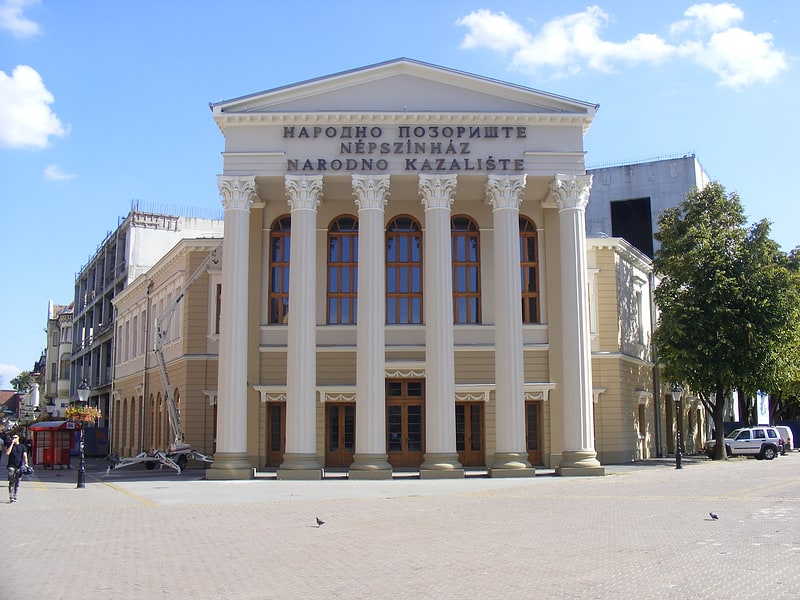
Also known as: Народно позориште
Theater in Subotica, Serbia. The National Theatre is a theater in Subotica, Serbia.[18]
Pirot Fortress, Pirot

Also known as: Пиротски Град
Fortress in Pirot, Serbia. Pirot Fortress or Momchilov grad is situated in Pirot, Serbia. It was built in the 14th century by Bulgarian brigand and local ruler Momchil. In 1344, the regency concluded a further alliance with Bulgaria, which required the surrender of Philippopolis and nine other towns in northern Thrace along the river Evros. Nevertheless, after their occupation, Ivan Alexander refrained from direct action against John VI Kantakouzenos' forces operating in southern and eastern Thrace. At the same time, Momchil, a former brigand whom Kantakouzenos had entrusted with control over the Merope in the Rhodope mountains, switched over to the regency. It was supposed to serve as a defense against the Turks along the ancient Roman road called Via Militaris which connected Belgrade to Constantinople.
Pirot Fortress was declared Monument of Culture of Great Importance in 1979, and it is protected by Republic of Serbia.[19]
Romanian Orthodox Cathedral, Vršac

The Romanian Orthodox Cathedral or specifically Cathedral of Lord's Ascension in Vršac is a cathedral in Vršac, Vojvodina, Serbia, consecrated in 1912.[20]
Zrenjanin City Hall, Zrenjanin
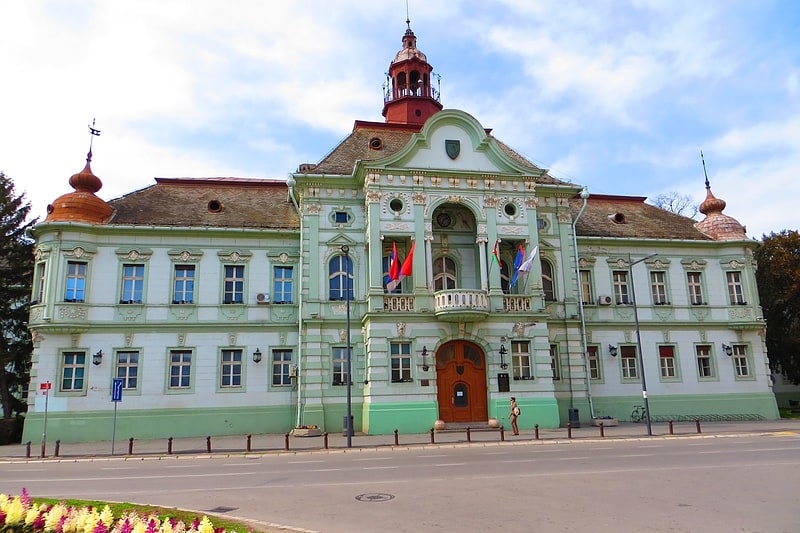
Also known as: Градска кућа
Zrenjanin City Hall is located at the Trg Slobode in Zrenjanin, Serbia. It is a seat of the Zrenjanin municipality.[21]
Address: Трг Слободе, Zrenjanin
Đurđevi stupovi, Novi Pazar
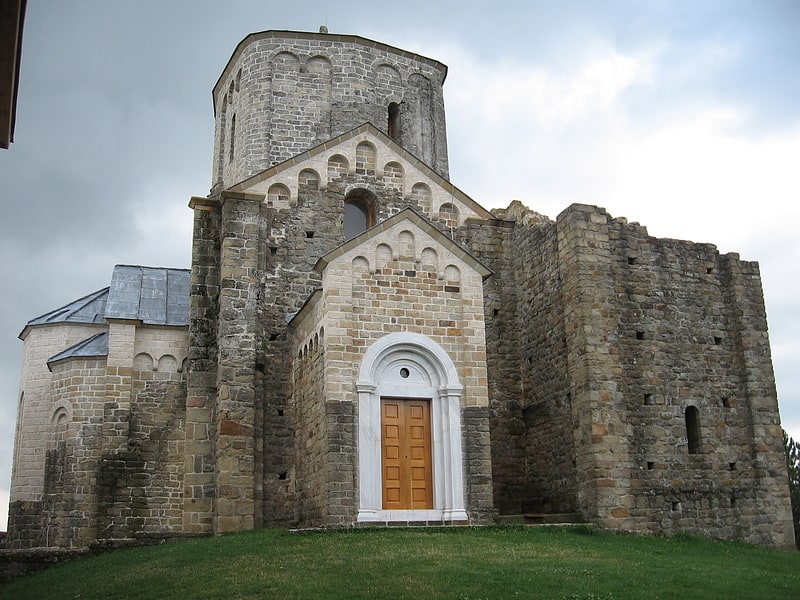
Also known as: Манастир Ђурђеви ступови
Monastery in Boturovina, Serbia. The Đurđevi Stupovi Monastery is a Serbian Orthodox monastery located in the vicinity of today's city of Novi Pazar, in the Raška region of Serbia.
The monastery is located near Novi Pazar, on the top of a prominent elevation covered with woods. It was erected in ca. 1170 as an endowment of Grand Prince Stefan Nemanja, dedicated to St. George; it is known as the "Tracts of St. George", often incorrectly as "Pillars of St. George". The monastery is exceptional not only for its position and significance it had according to medieval chronicles and manuscripts, but also for its particular architecture. It was named after the church dedicated to St George and its two former bell towers, two high towers – pillars (old Slavic language- stolp, stub). Namely, according to Stefan the First-Crowned, Nemanja had built this church to commemorate his gratitude to St. George for saving him from dungeons-caves where he was put by his brothers.
The monastery complex consisted of church of Saint George, dining-room, refectory, water tanks and walls around entry tower. The architecture of the Saint George Pillars Monastery is very characteristic representing unique synthesis of two medieval construction concepts, Byzantine in the East and Roman in the West. Monastery is a building with a set of architectural and construction innovation in that period, among which there are two remarkable towers, lateral vestibules, cupola with elliptic basis, irregular shape of altar area, as well as specific arrangement of the central dome space of the church. Single-aisle temple with the altar consisting of three apses, naos and narthex, in its external appearance reflects the spirit of Roman construction. The combination of Byzantine spatial arrangement and Roman architecture resulted in original symbiosis that has been the ground for special architectural style. The entry tower, after the additional construction of apses in the east side in 1282–83, had been turned into chapel that king Dragutin designed for his tomb. The inside of the chapel is covered by frescos with historical content and portraits of the Nemanjics. The frescoes of this Monastery, rendered in the best tradition of the Comnenus style and skillfully adapted to the architecture of the temple, which is especially pronounced in the all-embracing cupola, have particular value. The most impressive is the picture of Saint George on the horse, which is above the main entrance in the church. Beside this very distinctive one are frescoes of four Serbian state councils where important decisions related to the Serbian history were made. A small building has been erected in front of the monastery and it is used as a museum for the protection and exhibition of the most important fragments from church and other structures, where some have been fully composed and reconstructed. As a part of the entity Stari Ras with Sopocani, Saint George Pillars Monastery has been on the list of UNESCO World Heritage Sites since 1979 and it is on the Transromanica Route.[22]
Church of the Nativity of Christ, Pirot

The Church of the Nativity of Christ, also known as The Old Church, is a Serbian Orthodox church building located in Pirot in the district of the same name in southeastern Serbia. It is listed as a Protected Monument of Culture.[23]
Synagogue, Subotica
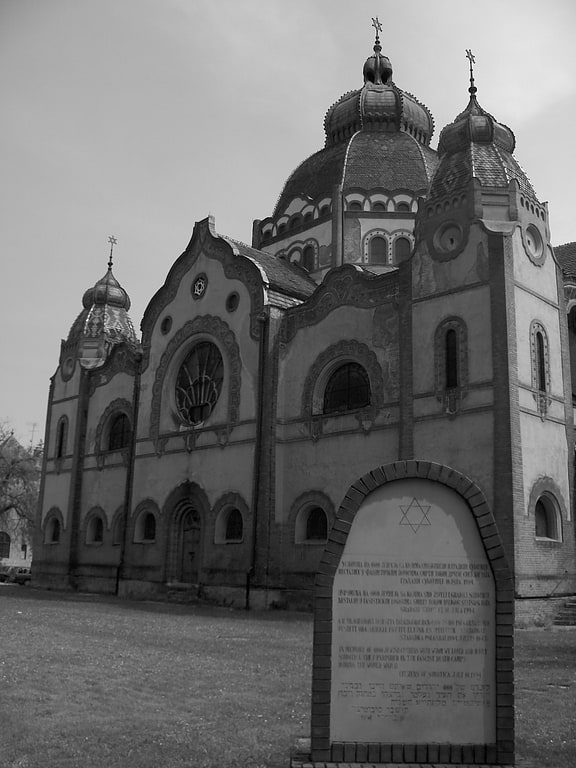
Synagogue in Subotica, Serbia. The Jakab and Komor Square Synagogue in Subotica is a Hungarian Art Nouveau synagogue in Subotica, Serbia. It is the second largest synagogue in Europe after the Dohány Street Synagogue in Budapest. It was built in 1901-1902 during the administration of the Kingdom of Hungary, according to the plans of Marcell Komor and Dezső Jakab replacing a smaller and less elaborate synagogue. It is one of the finest surviving pieces of religious architecture in the art nouveau style. It served the local Neolog community.
In 1974 the synagogue was designated a Monument of Culture; in 1990 it was designated a Monument of Culture of Exceptional Importance, and it is protected by Republic of Serbia.
The synagogue has long been plagued by conservation issues, though a decade-long partnership between the government and World Monuments Fund that ended in 2010 rendered the building watertight after years of water infiltration. Work on the restoration of the facades is the next phase of work on the synagogue.[24]
Address: Trg sinagoge 2, Subotica
Altun-Alem Mosque, Novi Pazar
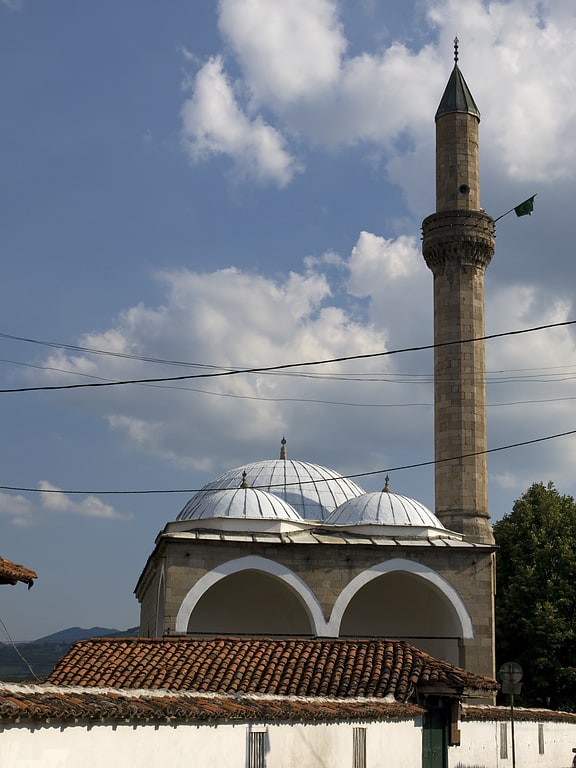
Also known as: Алтун-алем џамија
Mosque in Novi Pazar, Serbia. Altun-Alem Mosque is a mosque located in Novi Pazar, Serbia.
Altun-Alem Mosque was built in the first half of the 16th century by architect Abdul Gani.[25]